Yugo
No other car company has gone through as much adversity as the Zastava Corporation, known for manufacturing Yugo cars in the U.S. The company has persisted amidst the problems and difficulty they had faced, and are now operational once again as they prepare to return to the European and American market.
Zastava was originally founded as an arms manufacturer in 1853. The company started producing a number of vehicles during the outbreak of the war in 1941, but it was only in1953 that Zastava released its first passenger model car called the Milletrecento powered by a 1300 cc engine. However, most of their successful car models during those times, which featured a restyle rear panel and became available as a hatch back, were taken from Fiat designs, most in particular the Fiat 128 model.
In 1984, Zastava saw its name changed to Yugo after automobile entrepreneur Malcolm Bricklin pushed the company to test the U.S. market. However, Bricklin asked the help of Tony "Hurricane" Ciminera to make the necessary changes with the car to suit the competitive U.S. market. Yugo immediately held the cheapest car sale in the U.S. going as low as $3,900 for the GV ("Great Value,") more than a thousand dollars cheaper than the nearest rival. The usual features such as full carpeting, fabric upholstery, opening rear quarter windows and a lot more were present with the Yugo. Upon hearing this, consumers stormed their way to Yugo dealerships and placed their orders for the car. In fact, orders were five times the 1500 cars that were shipped to dealers. Along with the GV, Yugo also distributed the GVL and GVS featured minor upgrades in upholstery, and the GVX boasting a five-wheel manual transmission, 1300 cc engine and standard equipment.
However, a car this cheap comes with major flaws in its design and performance. Owners have complained about engine failures, faulty electrical services and burdensome maintenance associated with using the car. It got even worse when insurance companies credited fatalities caused by the Yugo due to its mechanical problems. Despite counter-arguments in defence of Yugo, the company went bankrupt in 1989 and has incurred almost-irreparable damage to its reputation. The company has also incurred the wrath of popular culture. In the American comedy show Whose Line Is It Anyway?, host Drew Carey refers to a "fully loaded, top-of-the-line, Yugo" as useless.
Due to the fact that Yugoslavia was engaged in war in the early 90s, which made car production unstable, Yugo finally folded in the U.S. To make matters worse, NATO bombed Zastava Corporation in 1999 when the car manufacturer was discovered to have been producing strategic arms.
It wasn't long before Yugo got back on its feet once again in Yugoslavia to produce its car models. The sanctions imposed by the United Nations against Yugoslavia have prevented the company from distributing its products all over Europe and the U.S., but it won't be long before Yugo will eventually see light in the U.S. market once again.

Original Authors: Manny
Edit Update Authors: RPN
Updated On: 15/08/2007











